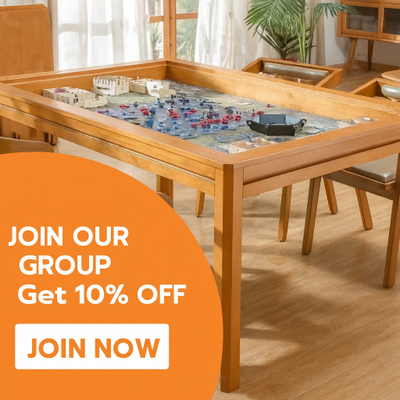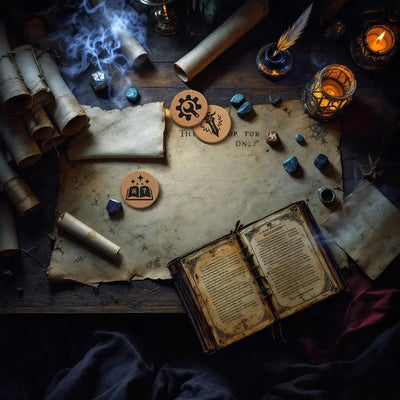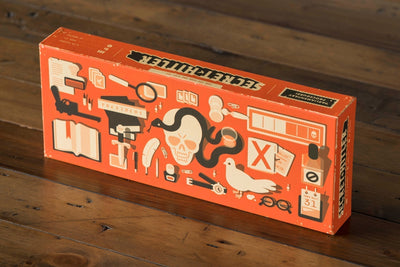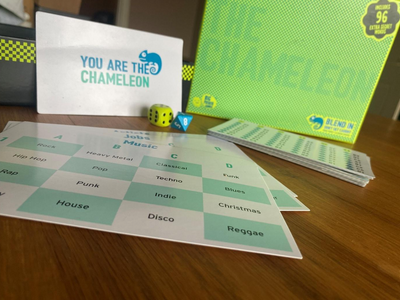Vantage: A Whole World to Explore!

John Gross
Vantage, Published 2025 by Stonemaier Games
Designer: Jamey Stegmaier
Artists: Valentina Filic, Sören Meding, Emilien Rotival
Developers: Garrett Feiner, Travis Willse
Graphic Designers: Christine Santana, Karel Titeca
Vantage is the hot new cooperative, open-world exploration game from Stonemaier Games. Designer Jamey Stegmaier spent over eight years building a world for us to explore, and it shows. This review will contain a few small spoilers.
Table of Contents
Introduction Story Setup
The game starts with players on a spaceship heading to an unknown planet after receiving a mysterious message from The Traveller (a character who appears throughout the game). Your spaceship malfunctions, and each player heads to an escape pod and lands at a random, different location on the planet.
Components Box Organization
The game arrived nicely packaged, with a lot in the box:
- About 400 large double-sided location cards, with beautiful artwork depicting your vantage point at each location on the planet.
- About 900 smaller item cards, each representing something you can encounter on the planet. This includes sentients (the intelligent beings who live on the planet; you are the aliens!), weapons, tools, vehicles, animals, plants, crystals, spells, curses, and who knows what else.
- 12 skill dice, corresponding to available actions on each Location card
- 20 challenge dice: rolled each time you choose an action to determine the impact of the action: potentially a loss of health, time or morale, the 3 statuses that are tracked throughout the game.
- 60 cardboard skill tokens (10 each of the 6 types). These are used to reduce how many challenge dice you must roll for a challenge of the corresponding skill type.
- A whole lot of silver wooden boost cubes, that can be used in various ways to mitigate damage or otherwise help you along in the game.
- 45 cardboard coins, in 4 denominations with a sci-fi theme.
- Tokens to represent your current health, time and morale, for each of up to 6 players
- Story books corresponding to each of the 6 skill types; the action you choose each turn combined with the Location or other card you chose it from combine to point you to a short passage to read in one of the storybooks.
The cardboard insert that came with the game is well-designed, keeping everything well-organized.
Game Setup Character Overview
Setting up the game is a breeze, and is pretty much just playing a couple of starting turns to get each player their character (one of 6 cards to start their tableau, each with a different skill advantage), a few skill tokens, and a starting location on the planet. Thematically you have each crash landed on your own, but you’re in radio contact with your teammates. You can describe your location card to the others but not show it to them. Your character has advantages that nudge you towards a particular skill/action alignment, and as the game progresses you can learn more about your character’s backstory. It’s not a role-playing game, but you can lean into your character and use that to help craft the story that is unfolding. Players/characters can help each other in a few ways. There is also a random mission chosen for the group, a goal to work towards that might or might not be your focus for the game.
Gameplay Mechanics
Each turn consists of choosing an action, either on your Location card, the Mission card, your Character card, or one of the item cards you have collected. Each action corresponds to one of the 6 skills. You look up the action for the number on the card in the corresponding story book, and first find out the difficulty of the action. This is the number of challenge dice you need to roll. Any player may spend skill tokens corresponding to the action type to reduce the number of dice rolled. Every action will succeed, but the result of the challenge dice roll may result in some damage to your Health, Time or Morale. Items (cards) you collect as the game unfolds provide places to place challenge dice to mitigate damage.
Difficulty Curve Replayability
At the start of your first game, you know nothing about the planet, or what you should be doing. That’s uncomfortable for some people, and exciting for others. As you explore and try things, you gradually figure some things out, and get better at finding your way around. It’s not as legacy game; each play starts from scratch, but you do carry forward knowledge about what might be available and how some things work. The experiences are different each game. Sometimes I have felt like I was aimlessly wandering around without much purpose, unable to progress toward completing the mission. Other times amazing things happened. I’ve repaired a spaceship, learned magic spells, been cursed, made friends, killed creatures, and gotten lost in a maze of caves. The depth and breadth of the game’s content is amazing, and there are lots of surprises.
You need to be careful at the start of the game, when you have few cards in your tableau to absorb damaging challenge dice. As you learn more about the game, you can build up a good amount of mitigation capacity, and the game becomes “easy”, in that you’re no longer worried about dying, and can just explore and take bigger risks. I don’t consider this a flaw. This game is not about winning or losing as much as exploring and experiencing. I’ve had several games where we completed our mission or destinies (alternate goals that can arise during the game), and we decided to just keep on playing, because there was more to accomplish. A typical game for me has been 3-4 hours, though usually there is an opportunity to be done after about 2 or less.
There are puzzles and mini-games embedded in this game. Some of the puzzles are easy and fun. A few are pretty difficult, and not all lend themselves to multiple players contributing to solve them. There is a “spoiler pack” of cards that you open up when instructed. Those are used for a minigame that you can play at many points in the game.
Of my 16 plays so far, about half have been solo. The game moves quickly that way and is a lot of fun. I’ve played 2 player a few times. An hour into a game with my wife I made a comment like “oh, that often happens early on in the game”, and she said “this is early? I’m done!”. At that point I lost radio contact with her character, and continued exploring the planet on my own. That made me realize that this game handles players leaving or joining the table at any point in the game simply and thematically. “Oh, your escape pod just crash-landed? Tell us what you see around you and start exploring!”. Not many games support that.
Enhancements Personal Modifications
I opted to buy the wooden skill tokens to replace the cardboard ones, and the metal coins as well. I’m very pleased with the quality of each of those, and they enhance the game play for me, even though I have played a few games in which the coins did not get used much at all. The dual-layer player mats help to organize the tableau of item cards you build throughout the game. I also bought metal 8mm silver cubes from the BoardGameGeek store to replace the stock wooden cubes, and am very happy with these. They are shiny and nicely hefty.
The other significant improvement I’ve made is to 3d print an insert to improve the storage of the game and speed up cleanup at the end.

The stock insert that comes with the game. Photo by Pouya Ostadpour
A good insert helps with storage and organization, speeds up setup and tear-down, and makes game play more enjoyable. The insert I printed (designed by BoardGameMeta and downloadable at https://makerworld.com/en/models/1641571-vantage-organizer-insert#profileId-1734613) accomplishes all of these goals. This insert also lets me fit everything in the box (including the dual-layer player mats) with no lid lift. I love a great insert! I also 3d printed a replacement for the centre game board (which is thin cardboard), where you track status and manage dice. This saves table space and keeps things from sliding around. It’s designed by tntfriesen1 and downloadable at https://makerworld.com/en/models/1661508- vantage-board-game-center-replacement-unofficial#profileId-2005015)

Final Thoughts
This game is not for everyone. If you expect the game to guide you with clear rules and direction on your turn, you may not enjoy it. If you want to play around and try crazy things with few limits, it’s a great ride. I think the sweet spot for the game is at 2 or 3 players. There is enough interaction to keep it interesting, but with more than 3 players I think I would get impatient waiting for my turn to come back around. I’ve heard of great games with 6 players, but I’m not keen on trying that.
I played Vantage about twice a week for the first several weeks. Since then, my obsession has subsided, but I’m still looking forward to returning to the planet. After 16 plays and about 50 hours of play, I am still finding new things every time, and seeing little repetition from game to game. There are still many unknown missions to attempt, and lots more to learn about what makes up this strange planet, the beings who inhabit it, and the characters we use to explore it. It’s not a cheap game, but it comes complete with an incredible amount of content packed in the box. This is a remarkable and unique game, with amazing depth, and a unique pull that I have not felt from other games.

John Gross
After 25 years developing Oscar winning animation software, John Gross built a successful rock climbing gym in 2009 that continues to grow and thrive. His love of board games began in high school with countless games of Risk and Diplomacy, which both cemented and destroyed friendships. In recent years, John has immersed himself in the modern board game hobby, using his new 3D printing skills to enhance games with 3D printed inserts and other upgrades. John lives in Toronto with his wife and 2 black cats.





